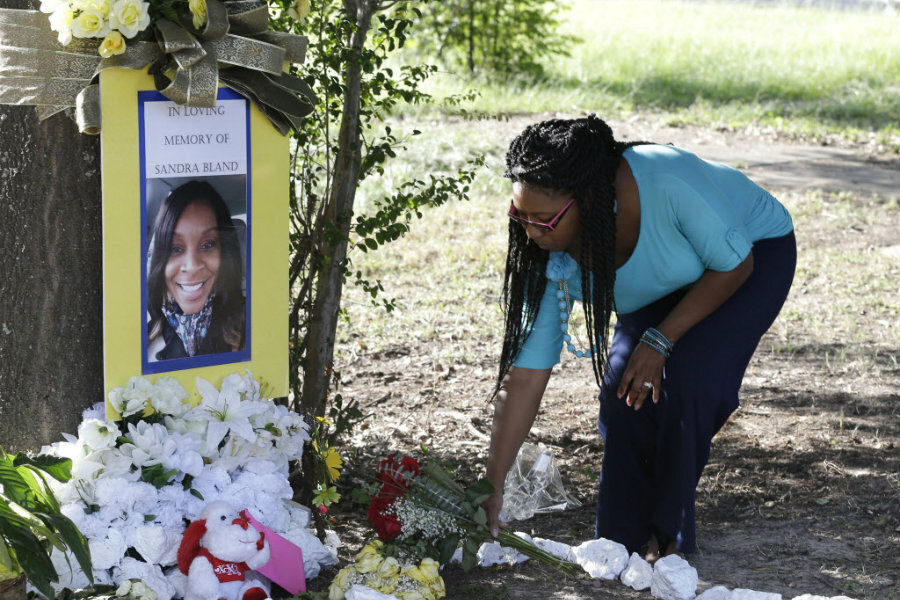Sandra Bland's injuries consistent with suicide, autopsy shows
Loading...
| HEMPSTEAD, Texas
The autopsy of a black woman who was found dead in a Texas jail revealed no injuries that would suggest she was killed by someone else, authorities said Thursday.
Waller County prosecutor Warren Diepraam said the autopsy showed that 28-year-old Sandra Bland had no defensive injuries on her hands that would typically indicate a struggle.
Some lacerations or abrasions were found on her wrists. Those were consistent with a struggle while being handcuffed. The marks around Bland's neck were consistent with a suicide by hanging, Diepraam said.
Bland also had about 30 small cuts on her wrist that were probably self-inflicted within the last few weeks, he added.
She was arrested in a traffic stop three days before she was found in her cell on July 13. Her family and friends dispute the official finding that she killed herself using a noose fashioned from a plastic garbage bag.
Texas Rangers and the FBI are investigating.
Also Thursday, the woman's sister confirmed that Bland had taken prescription medication for seizures in the past.
Booking documents filled out for Bland after her arrest indicate she told staff at the jail that she had epilepsy and was taking medication for it. The forms identify the drug as Keppra.
Other forms, however, say she was not taking medication.
Company information on Keppra, which is sold in regular and extended-release forms, says that "antiepileptic drugs, including Keppra and Keppra XR, may cause suicidal thoughts or actions in a very small number of people, about 1 in 500."
Sharon Cooper told The Associated Press that her sister suffered from seizures about a decade ago but had not had any in recent years and was not on medication.
The medication was not the only inconsistency in the jail-intake papers. One questionnaire said Bland took pills in 2015 in an attempt to kill herself after losing a baby. A separate form filled out by another jail employee said the suicide attempt occurred in 2014.
Cooper said her sister had a miscarriage in May 2014, but got through it. Cooper also said she was not aware of any suicide attempt.
Asked if her sister could have been getting treatment without relatives knowing, Cooper said the family's five sisters were "above board" with each other and, if anything, "overshared."
"If it was happening, I would have known," she said.
Preliminary autopsy results also showed that Bland had marijuana in her system. The drug-test results are worth noting because they could be "relevant to her state of mind," Diepraam said.
Authorities said any contradictions in the jail documents were the result of Bland'sinconsistent answers to jailers' questions.
Bland's death comes after nearly a year of heightened national scrutiny of police and their dealings with black suspects, especially those who have been killed by officers or die in police custody. It has resonated on social media, with posts questioning the official account and featuring the hashtags #JusticeForSandy and #WhatHappenedToSandyBland.
Bland's family has said she was not despondent and was looking forward to starting a new job at her alma mater, Prairie View A&M University.
However, Bland posted a video to her Facebook page in March, saying she was suffering from "a little bit of depression as well as PTSD," or post-traumatic stress disorder.
Cooper said that "everyone has peaks and valleys" and that the Facebook video might indicate her sister was just having a bad day or a bad few days.
A video of her arrest taken from the officer's dashcam shows state trooper Brian Encinia drawing a stun gun and threatening Bland when she refuses to follow his orders.
The episode began when the trooper stopped Bland for failing to signal a lane change.
The conversation turned hostile after the officer asked Bland to put out her cigarette and she asked why she can't smoke in her own car. The trooper then ordered Blandto get out of the vehicle. She refused, and he told her she was under arrest.
The roadside encounter swiftly escalated into a shouting confrontation, with the officer threatening to drag her out of the car. At one point, he warned Bland, "I will light you up," if she doesn't get out.
Houston television station KTRK-TV released a voicemail that Bland left a friend, LaVaughn Mosley, while in jail in which she expressed disbelief at her circumstances.
In the message, Bland calmly said she's "still just at a loss for words honestly at this whole process." She wondered, "How did switching lanes with no signal turn into all of this?"
The trooper, who has been on the force for just over a year, has been placed on administrative leave for violating unspecified police procedures and the department's courtesy policy.
Keyser reported from Chicago.







